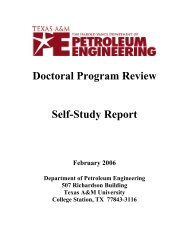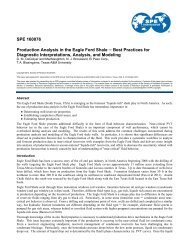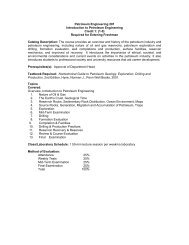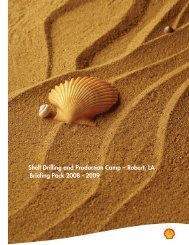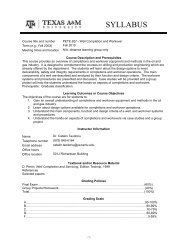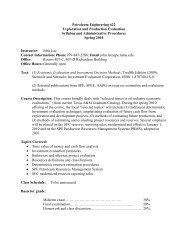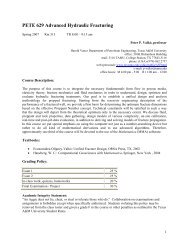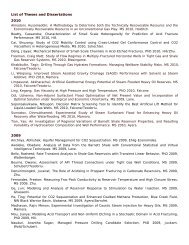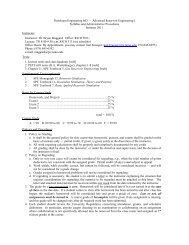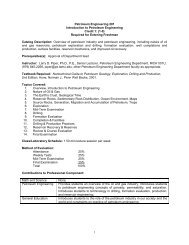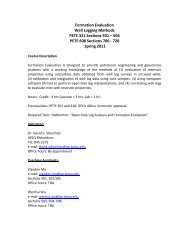Crisman Annual Report 2009 - Harold Vance Department of ...
Crisman Annual Report 2009 - Harold Vance Department of ...
Crisman Annual Report 2009 - Harold Vance Department of ...
You also want an ePaper? Increase the reach of your titles
YUMPU automatically turns print PDFs into web optimized ePapers that Google loves.
PRISE – Petroleum Resource Investigation Summary and Evaluation<br />
Introduction<br />
As conventional resources are depleted,<br />
unconventional gas resources (UGRs) are becoming<br />
increasingly important to the U.S and world energy<br />
supply. The volume <strong>of</strong> UGRs is generally unknown<br />
in most international basins. However, in 25<br />
mature U.S. basins, UGRs have been produced for<br />
decades and are well characterized in the petroleum<br />
literature. The objective <strong>of</strong> this work was to develop<br />
a method for estimating technically recoverable<br />
UGRs in target, or exploratory, basins. The method<br />
was based on quantitative relations between known<br />
conventional and unconventional hydrocarbon<br />
resource types in mature U.S. basins.<br />
hydrocarbon resources are conventional oil and gas,<br />
and 90% are from unconventional resources.<br />
Significance<br />
PRISE may be used to estimate the volume <strong>of</strong><br />
technically recoverable hydrocarbon resources<br />
in any basin worldwide and, hopefully, assist<br />
early economic and development planning. PRISE<br />
methodology for estimating UGRs should be further<br />
tested in diverse sedimentary basin types.<br />
Conventional is 0–9% greater<br />
10/13/<strong>2009</strong><br />
than in previous calculation From Old, <strong>2009</strong><br />
Objectives<br />
The primary objective <strong>of</strong> developing PRISE<br />
was to establish a methodology for estimating<br />
unconventional technically recoverable resources<br />
in basins with no, or very little, unconventional<br />
resource development or data. A second objective<br />
was to create a system the industry can use to<br />
better understand the potential <strong>of</strong> unconventional<br />
resources in the target basins around the world.<br />
Armed with such estimates and understanding, the<br />
industry can better justify its future development<br />
activities or, in some cases, change course. For<br />
this study, published resource information from the<br />
USGS, PGC, NPC, EIA, and GTI were used to quantify<br />
recoverable resources in seven North American<br />
basins.<br />
1<br />
Quantified Recoverable Resources – 7 N.A. Basins (Old, <strong>2009</strong>).<br />
Accomplishments<br />
To develop the methodology to estimate resource<br />
volumes, we used data from the U.S. Geological<br />
Survey, Potential Gas Committee, Energy<br />
Information Administration, National Petroleum<br />
Council, and Gas Technology Institute to evaluate<br />
relations among hydrocarbon resource types in the<br />
Appalachian, Black Warrior, Greater Green River,<br />
Illinois, San Juan, Uinta-Piceance, and Wind River<br />
basins. PRISE can be used to predict technically<br />
recoverable UGRs for target basins, on the basis <strong>of</strong><br />
their known conventional resources. Input data for<br />
PRISE are cumulative production, proved reserves,<br />
growth, and undiscovered resources. We use<br />
published data to compare cumulative technically<br />
recoverable resources for each basin. For the seven<br />
basins studied, we found that 10% <strong>of</strong> the recoverable<br />
Project Information<br />
1.1.20 Continued Development <strong>of</strong> PRISE<br />
Contacts<br />
Stephen A. Holditch<br />
979.845.2255<br />
holditch@tamu.edu<br />
Walter B. Ayers<br />
979.458.0721<br />
walt.ayers@pe.tamu.edu<br />
Kun Cheng<br />
CRISMAN INSTITUTE<br />
18<br />
<strong>Crisman</strong> <strong>Annual</strong> <strong>Report</strong> <strong>2009</strong>



